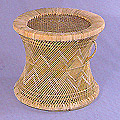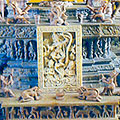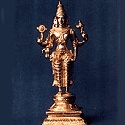The use of natural fibres like cane and bamboo is perhaps the most universal of all the crafts practised throughout the world. In Bangladesh fibres, reed, cane and bamboo have provided the rural people with most of their essential requirements; the huts in which they dwell, the mats for prayer and sleep, baskets, sieves and trays for various uses, caskets for storage of harvested crops. Baskets and mats are made everywhere in Bangladesh and an old Bengali proverb says that so fine and delicate should these be that they “can be rubbed on the eye without hurting”
RAW MATERIAL
One of most the commonly used is the giant bamboo / Bansh which grows abundantly in the forests. Known by the botanical name of bambusa, eleven species have been identified in Bangladesh, of these the three major species are the bambusa arundinacea (sheel or kanta bansh), bambusa telda (talla bansh), melocanna bambusoides (mulibansh). Bamboo forests are found in the deltaic tract of greater Dhaka, the rugged regions of Mymensingh, the hill tracts of Chittagong, further north in Sylhet and Nilphamari.
A second form of vegetation which has been used extensively by craftsperson is a tough and thorny creeper, known as calamus rotune or cane. In Sylhet, a superior quality of cane forms a natural growth, whereas a wild and inferior variety grows in other places. Due to the growing pressure to cultivate crops, cane cultivation is seen less frequently today. A wild shrub known as Maranta dichotoma grows in Sylhet and Noakhali. Known locally as Murta bet, Pati bet, Patita, or Mustag, the stems of this shrub are used for weaving. The old and therefore stronger shoots of the plants are always favoured.
The cane and bamboo are first split in two and then subdivided to form fine strips which are used as the warp and the weft for weaving. The strands are then steeped in the muddy waters of a pond, preferably one containing water-hyacinths, to further strengthen them, and then they may be dyed in different vegetable colours. To produce a fine shade of brown, the juice of the gab or kusi (the Wild Mangosteen Diospyros embryopteris) fruit is commonly used.
In the humid climate of Bangladesh the natural growth of reeds and creepers and their ease of availability have inspired a huge variety of crafts. Among them are:
BAMBOO AND CANE HOUSES
From time immemorial craftspersons have used bamboo and cane to make articles for their daily use. One of the most important uses of cane and bamboo is to be found in the construction of thatched village houses. Both cane and bamboo are a common media for interior decoration as well. In many village homes, a buffer ceiling is created by a hanging shelf designed elaborately with cane and bamboo. Known as phul chang (flower shelf), it is suspended from the ceiling in a prominent place. Is serves a useful purpose to store objects, but it also adds to the décor.
Thatch work on homes required highly skilled craftsmanship. In the Charya Pada, one of the early formal literature in Bengal, composed between the sixth and eleventh century, a bamboo structure is referred to thus: chari banshee garilare dia chanchali (with four bamboos and purlin was constructed a structure). In medieval Bengali literature known as Mangal Kayva such houses were bedecked with cane knots, split bamboo designs, mica sheets, mirror, feather and even jewellery. These houses were known as Bangla Ghar. Stylistic differences are distinguished by the number of ceilings so that houses are known as dochala or two-roofed, charchala or four-roofed, satchala or seven-roofed, and aatchala or eight-roofed. Even with split bamboo and thatch, village homes acquired an impressive height. Apart from the easy availability of this material for construction, there was a preference for the impermanency of such material over brick and mortar. This preference was conditioned by the need to dismantle the structure if threatened by river water erosion. The bamboo mats known as darma are often used as walls in the village homes in Bangladesh.
TRANSPORT
Since the rivers of Bangladesh provide a major source of communication and travel, it is inevitable that all crafts should lend themselves to be of use to the wide variety of boats. The curved roofs of country boats are made of decorated bamboo mats. In the north, where bullock carts are more common, a round bamboo structure is interwoven to provide a covering for the cart.
STORAGE STRUCTURES
Bamboo is useful for creating storage structures. In the courtyard of houses are found round granaries or golaghar. Made of bamboo purlin, these barns are given a very graceful shape, and decorated with cane knots or painted with geometric patterns. In Satkhira town we can still find an old granary in which the cane knots are tied in such a way that they depict flowers and birds. Another golaghar in Kushtia is painted in red, black and white geometrical patterns.
BASKETRY
Bamboo split lengthways is made pliable and woven into baskets of different shapes in accordance with its use. Basketry is most widely produced all over Bangladesh and almost every village market has a section earmarked for sale and purchase of baskets. Coiled basketry has the closest affinity to weaving. It is interesting to note that amongst the tribal people, the pattern chosen for weaving cloth is often repeated in their baskets and mats. Apart from a multitude of shapes and sizes, from rough storage jars to small delicate containers, basketry of this type is adorned with streaks of colour which create perfectly harmonised patterns. The baskets may be either woven or coiled, the former made up of warp and weft strands; the warp strands are fixed while the weft ones cross and re-cross the warp as in textile weaving. There are many common types of these woven baskets.
The dol, dhama, jhuri, saji etc. have different uses, to store and measure rice, to the market, to sell vegetable and so on. In addition split bamboo is used to make winnowing fans (kula), sieves (chalni), to hold fish (doola). Tribal artisans make round and cubic boxes known as jhail and thrung to pack cloth. The tea pickers of Sylhet sling conical shaped baskets over their shoulders, mango growers of Rajshahi use broader based baskets. For domestic work, millions of women all over the country use baskets.
Some forms and shapes of baskets are connected with ritual use – both secular and religious. For example, the phuler shaji is used to pluck flowers for puja, whereas the Lakshmi ari or jhail is used in some parts of the country, as a substitute for the goddess Lakshmi’s image. Colourful bier dali made in two or three layers of coloured, woven bamboo strips, is a specimen of the ritual art of the Banshi Mali community of Rangpur. It is used to carry ritual gifts to the bridal home.
The process followed to make a bamboo basket starts with the purchase, from the local village market, of bamboo that is approximately 22” to 23” in length and green in colour that is cut into sizes suited to the basket required. The bamboo is split into several thin strips of 3mm with the bill hook or dao, and spread out for drying for about 2 hours in the sun. The dried strips are then scraped with a sharp knife to smoothen the rough edges and remove fibres with further thinning being done to achieve flexibility in the strips.
The artisan meanwhile prepares various colours if the object is to be coloured. The dyes are usually powders that are mixed in water. The thin bamboo strips when soaked for an hour acquire the required colour. Primary colours are commonly used.
The start of the weaving for a shallow, round, flat basket (dala) begins with strips of bamboo of 1/8” width and 20” length being readied with approximately 48 pieces assembled in a criss-cross manner to form the centre of the basket. The weaving is completed by inter-lacing of warp and weft strips up to the required size, keeping the material soft with repeated wetting. The artisan prepares the outer rim of bamboo in approximately 52” length, which is used to circle around the outer edge of the woven material securing the matting by interlocking of the bamboo strip ends between the finely split double circular layer of the rim. The rim edge is secured further by binding the rim with soft bamboo strips at regular intervals. The basket, square at the bottom and round at the rim is thus complete and ready for use.
The wide variations of forms and shapes used for different purposes have an equally wide weaving pattern. In basketry five different patterns can be discerned. These are check, willed, twined, wrapped and hexagonal weaves. In the simple check weave, the warp and weft are woven singly one upon another. In the will weave a single weft is woven over and below more than one warp. By expanding and contracting and inserting coloured strands, numerous designs are woven. In the twined pattern, two or more wefts cross the warp forward and backward. In wrapped weaving the wefts are passed over warp, which is twisted in the process. In the hexagonal weave, wefts proceed from three sides and fabricate figures with six angles and sides or in a six cornered star.
TRAPS
Fishing is one of the primary occupations in Bangladesh. The preparation of fishing nets, traps and baskets has traditionally involved distinct communities. In travelling to different regions we find a remarkable variety of fish traps. Their shapes, circular, square, cube or oval are determined by the function, and the form of fish to be caught. Although they are mostly made of thin bamboo strips, sometimes the strips are woven. Artisans use their skill to fashion such highly utility items into aesthetic forms. The most elegant fish traps are to be found in Nilphamari, Kumarkhali and Kushtia. A similar use of bamboo is also found in the preparation of cages and bird traps. Cane and bamboo are used to produce many types of traps, each with a distinctive shape and ingenious method of operation. Woven sieves, fans and baskets are interspersed with geometric motifs like diamonds of many sizes, stars and crosses. The borders are selvedge in linear patterns.
HAND FANS
The weaving technique is used in two important rural crafts: fans and mats. Both of these are particularly useful in villages where electricity is unavailable. In the hot, tropical climate of Bangladesh, hand fans can be used to simulate a cool breeze, and mats spread on the floor are cool and comfortable to sit and sleep on.
Traditional craftsmanship has excelled in the making of hand fans. Hand fans, made from bamboo, cane or reeds are light and portable and require very little effort to revolve manually. In making these fans, pretty patterns are introduced by interpolating strands dyed in different colors onto a circular bamboo frame. Woven fans assume stylized forms that are named after familiar objects such as Kanchi kata (scissors cut), pan guchi (betel leaf bunch), pukuria jo (pond motif), tara jo (star motif), kabutar khop (dovecot), sagarer dheu (sea wave), makarer jal (cobweb), cha baganer bera (tea garden fence), Pabnaia jo (Pabna motif) etc.
FURNITURE AND URBAN PRODUCTS
In Sylhet, craftsmen are skilled not only in traditional crafts, but in deference to modern taste they have started producing chairs, tables, stools, screens made of cane and bamboo. To meet the demand from sophisticated buyers both in the city and outside Bangladesh, the craft has undergone a metamorphosis. Artistically fashioned baskets have found their way from a village home to the homes of craft connoisseurs. Due to the initiative of craft promoters and the artisan’s ingenuity, these products have entered the international markets. Consequently, there is a brisk trade in basket ware and other products made from cane, bamboo, grass and reed. Contemporary items in bamboo are made in Comilla, Tangail, Dinajpur and Narsingdi. Modern cane baskets are supplied from Munshiganj, Nababganj, Sibalay, Tangail, Pabna, and Comilla. Leaf fiber and grass items are procured by craft dealers from Jessore, Khulna, Bogra, and Kaliganj. Almost fifty to sixty varieties of baskets are now available in the urban market. In bamboo, we find plate baskets, snake baskets, doll baskets, half cylinder, flower pots, hexagonal tray, glass, cover, lamp shades, waste paper baskets etc. Modern products in cane are bottle holders, pot holders, picnic baskets, ginger baskets, trays, wall hangers, etc. Articles made of leaf; grass, fibre etc. are laundry baskets, shopping bags, sewing baskets, table mats etc.
To produce cane objects, cane of different thickness is purchased from the local market and dried in the sun for about 10 days. To test whether it has dried sufficiently the piece is bent, if it returns to its original position when the pressure is removed, then it is considered not fully dry. Once dried the cane is cut to size, the top surface scrapped with a knife, rubbed over with sand and washed in water. The cane is curved to shape either by hand or by heating over a sprit lamp or blow lamp. Once the cane is bent to the required shape, fine nails are put in to retain the shape. The artisan works freehand, to shape baskets and small objects, but uses measurement tools and other gadgets for screens, and furniture. The bent or curved cane nailed into position, is sometimes covered over with a binding of smooth flexible strips of cane, so that no rough or blackened portions are visible. Once the object is shaped, (mirror frames, stools, chairs etc.) it is rubbed over with sand paper to remove rough surface fibres, and varnish is brushed into it to give a shiny finish. The object is placed in the open for drying, which takes about 2 hours, in dry weather.
JEWELLERY
In Aandpur village the hard and stiff bamboo is turned into various artifacts such as bangles, ear rings, chains, jewelry boxes, etc.
DEVELOPMENTS
Many organizations have encouraged the craftsperson’s to produce for the market, in order to increase livelihoods, the among the most prominent are the International Union for Child Welfare (IUCW), Shetuli, Karika, BRAC/Aarong, Bangladesh Handicraft Marketing Corporation and Bangla Craft. Not only have designs changed but some artisans have, at places with the assistance of the Bangladesh Small and Cottage Industries Corporation, adopted new tools to increase their productivity. They are also learning the use of chemicals to protect their craft from fungus.
However in the vast number of villages, the pristine simplicity of old forms is retained. Traditional techniques relying on elementary tools such as the dao to split the bamboo, a boti to shave the cane remain largely unchanged. Production continues to be organized within the family, where specific functions are distributed amongst men and women.



